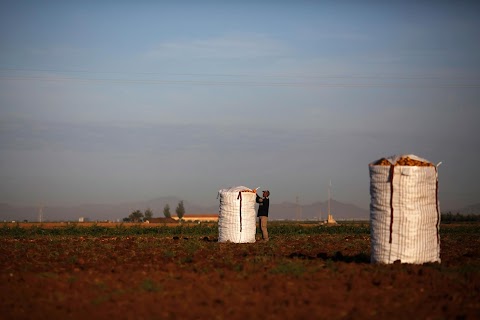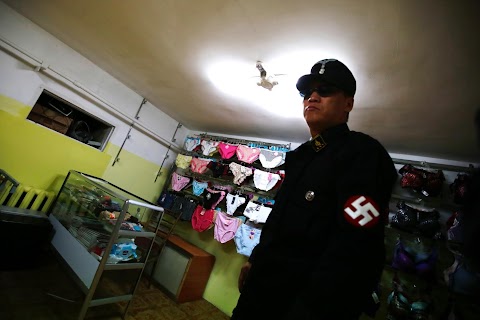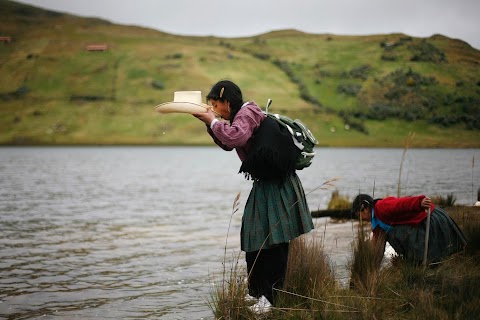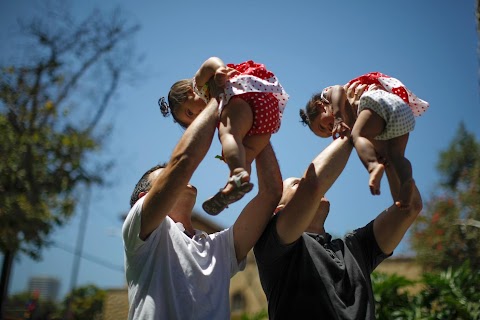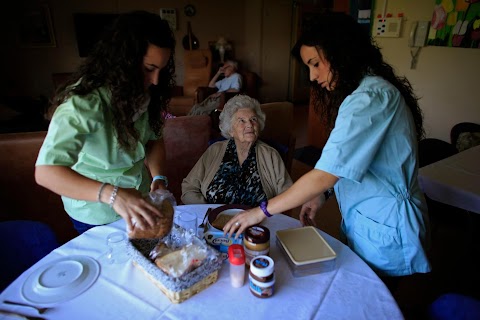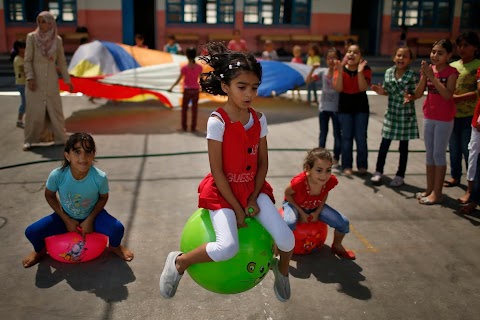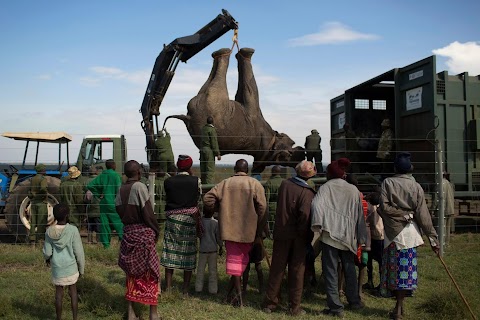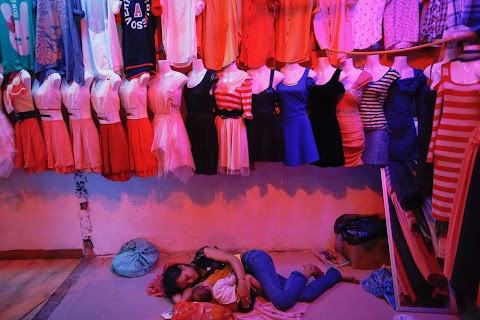
Strike and struggle in Phnom Phen
 Damir Sagolj
Damir Sagolj
With a row of dresses dangling above them, a mother lies curled up around her baby on the floor of a market in the Cambodian capital Phnom Phen. They are not far from an area where factories churn out garments like the ones that hang over their heads, and many of the people who make them sleep in even less comfortable surroundings. Conditions for Cambodia's more than 300,000 garment workers can sometimes be grim. Now as investment in the country’s textile industry is surging, so too is labour unrest.

Maen Sopeak is a 24-year-old garment worker in a suburb of Phnom Penh. She is one of seven girls, all garment workers too, who share a single, four-by-four meter room for $35 per month in a building packed with similar tiny apartments.
Most garment workers who arrive from the provinces to work at factories in Cambodia's capital live in tiny spaces like this – some barely larger than the changing rooms where the clothes they make might be tried on. Four or even more people can share a room of three by three meters, with just one light and one electric fan.

Outside the apartment buildings, living conditions can also be very cramped. This woman, her grandchild, and the baby’s father are part of a family of four, who left their province searching for a better life and now live in a four-by-four meter wooden shack by a garment factory. They pay $25 a month in rent.

A group of garment workers employed by a company named Sabrina (Cambodia) Garment Manufacturing Corp, which produces clothing for the U.S. sportswear brand Nike, brandish signs at their union headquarters in Phnom Penh. Up to 4,000 of the company’s 5,000-plus employees went on strike recently and police intervened to end protests on May 27 and June 3, when some strikers rampaged through the factory.
The incident came as industrial action is becoming more common in Cambodia. Strikes by the country's garment workers nearly quadrupled last year to 134, industry body the Garment Manufacturers' Association of Cambodia says. So far this year there have been at least 48 strikes – already more than in the whole of 2010 or 2011.
Slideshow

A girl plays with a balloon at a market outside one of the industrial zones where factories are based in a suburb of Phnom Penh.

Garment workers shop at a food market near a factory zone.

A mannequin's head lies in the window of a beauty salon, in a suburb where garment factories are based.

A young woman sells beauty products.

Garment workers shop at a food market.

A woman sits and prepares food at a building packed with garment workers' apartments.

Fish lies inside a colander before being cooked for lunch.

A man stands in the doorway of a room inside a building housing garment workers.

Twenty-two-year-old garment worker Sim Channan washes clothes as she sits between plastic buckets and pipes marked with residents' room numbers.

A pair of colourful slippers lie outside a room.

Garment workers sit on the floor of a four-by-four meter room that seven of them share.

A toy hangs out to dry in an apartment building where garment workers live.

Ran Oeun Chany (centre), her husband Sim Sarath (right) and friend Kim Heang sit in a room with clothes hanging up behind them.

Twenty-three-year-old garment worker Eng Chen waits to be given intravenous therapy at a one-bed private clinic in a suburb of Phnom Penh.

Garment workers cast shadows on a wall as they arrive for work.

Workers ride to their factory on a truck.

A man sells food to garment workers as they arrive.

Employees with Sabrina (Cambodia) Garment Manufacturing Corp discuss the next steps of their strike outside a factory in Phnom Penh.

Workers smile and clap as a union representative tells them the results of a strike.

Garment workers for Sabrina (Cambodia) Garment Manufacturing Corp hold out pictures of colleagues who were arrested.

Unemployed women wait for information about possible jobs as garment workers.

People sit and wait for garment workers to leave a factory.
"With no education and no money to invest in something more profitable, the garment industry seems to be the only option."
Like a true professional, Maen Sopeak sings to the audience of seven people who sit on the bare floor of her room in a Phnom Penh suburb. Her singing is soft, at moments almost a whisper, but her beautiful voice is clear. In a country even slightly richer than devastated, impoverished Cambodia, she could be a star.
Maen Sopeak is, however, just a poor garment worker. There will be no sell-out crowds or fancy dresses for her anytime soon. She shares a single, hole-in-the-wall room with six other women, who all work at a nearby garment factory producing clothes for Western brands.
The song is excruciatingly sad. It tells the story of a girl forced into marriage with an older man, not the one she loves. Maen makes the grim song sound somehow joyful, although suicidal thoughts would be more appropriate. The abject conditions in which she lives and works are a natural setting for this tragic ballad. Here, misery invites yet more misery. Just like in my home country of Bosnia, another devastated, post-genocide land where sevdah music is just a natural extension of everyday hardship.
I’m in Cambodia for five days to do a story on garment workers. The idea is to see how these women live, and to shine some light on the conditions that they are in before tragedy strikes (which I hope will never happen). Working conditions are better than in Bangladesh, but not by much. After a building collapsed in Bangladesh in April, killing more than 1,000 workers in the deadliest disaster in the history of the garment industry, more business has come to Cambodia. Many fear more accidents will follow.
I knew coming here was not going to be easy. No matter how long I stay, or how good or lucky I am, many layers of this complex story will remain unseen. What I have seen and photographed is not easy to put into one picture or into a single thought.
Cambodia’s garment industry is big and getting bigger. More than 300,000 workers produce the clothing, mostly for exports. There is a high chance you have worn clothing from Gap or H and M that has been stitched together here.
Demand and investments are surging. So, too, is labour unrest. That’s no surprise. Although salaries and conditions for workers in Cambodia are not as bad as in Bangladesh (the monthly minimum wage is $80, compared to only $38 in Bangladesh; in China it is $150) protests and strikes quadrupled over the last year. There have already been 48 strikes this year, more than in the whole of 2010 and 2011 combined.
In the village of Trapeng Weng, just outside Phnom Penh, more than 400 people work in a factory that makes products for Nike. “Police come every day to look for me, sometimes in uniform, sometimes as civilians,” says a man who claims to be on the black list for his role in recent and violent protests. The pay is not enough, he said, explaining the reason for the unrest. The government raised the minimum wage to $80 a month in March this year but workers complain that it is not enough and pay rises have not kept up with the cost of living.
To survive with enough money left at the end of the month to send home, workers must live a very basic life. For those who come from the provinces, the accommodation is shocking: overcrowded buildings, four or even more people usually sharing “an apartment” as big as a changing room in a clothing store. They each pay rent of about $10 a month, plus more for water and for a single neon light installed on the bare walls. Another $10 or more goes toward transportation expenses. Food is getting more expensive.
To make ends meet, a worker has to be very lucky and not get sick or overspend on anything more than the bare basics.
The problems start when something goes wrong, such as a family member dying, or a debt collector turning up. Then they borrow, creating the vicious cycle of debt and poverty that has ruined so many families, communities and countries worldwide.
Not all survive such a hard life. In the stench of a city’s slum, in a room in which every other wooden floor plank is missing, where the tin roof turns into a microwave oven, a girl nicknamed D explains why she quit garment work and joined what is colloquially called the “entertainment industry” – basically prostitution.
“My mother died and it all went downhill from there. I needed quick money and could not wait for the next month’s salary. When I work in the park, it is more dangerous but I get money the same day,” she says.
For many others, work in the textile industry is as good as it gets and better than anything else they know. Chhem Sokhorn, 37, is getting ready for work in the family’s rice field. We briefly speak about her life before the morning turns into unbearable heat and the ever-smiling woman makes a point: she used to work in the garment industry but quit to be the only one from her family to take care of her household. Her daughter is at the factory and she hopes her other children will get jobs there, too. Yes, the garment industry pays little; the hours are long and the work is hard but that is much better than tilling a rice paddy a few months a year.
With no education and no money to invest in something more profitable, the garment industry seems to be the only option. Outside an industrial zone where factories are based, young, unemployed women gather at the gates hoping for part-time work. Day or night shifts, they don’t seem to care. Their families expect them to start contributing to their income.
The real problems will come later. The young and healthy can work a lot without asking too many questions.
They might dream about being a singer or an architect (like Man Chan Thea, the boy I photographed in a rice field who hates garment work because his sister is always so tired and sick from it).
But the reality is brutal and the society conservative. Investing in education or a career will not feed the family or pay existing debts. For many people I met outside walls of the factories, it is about sheer survival, nothing else.


